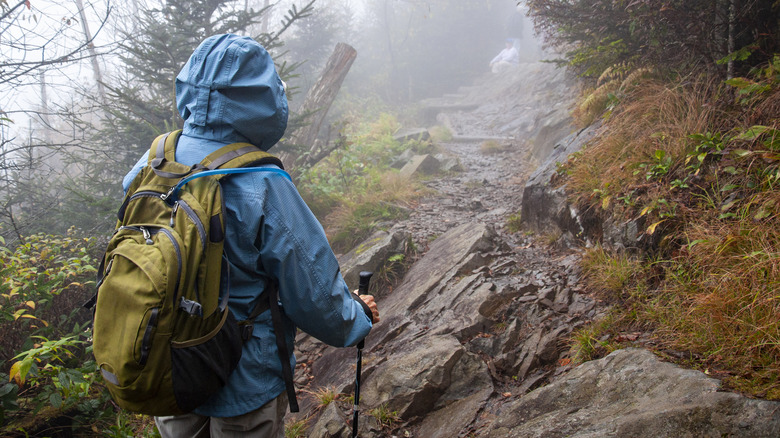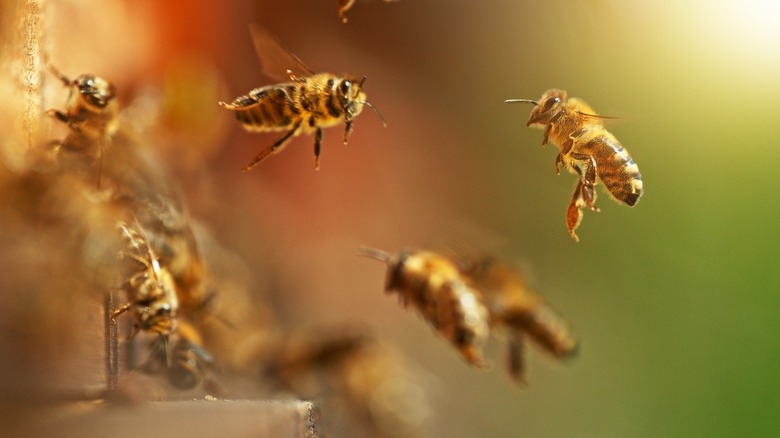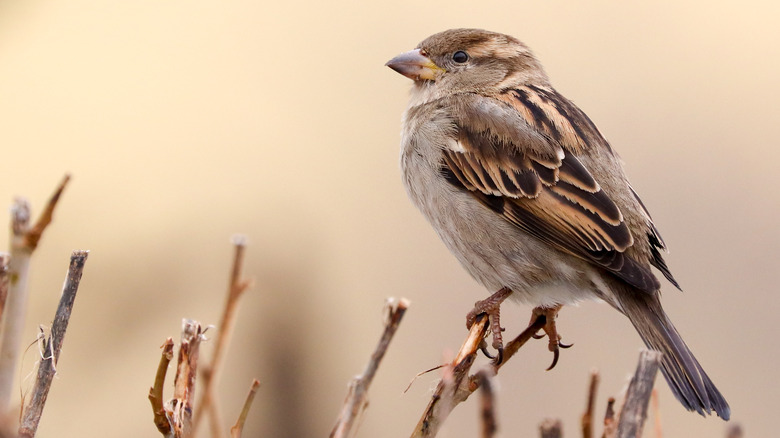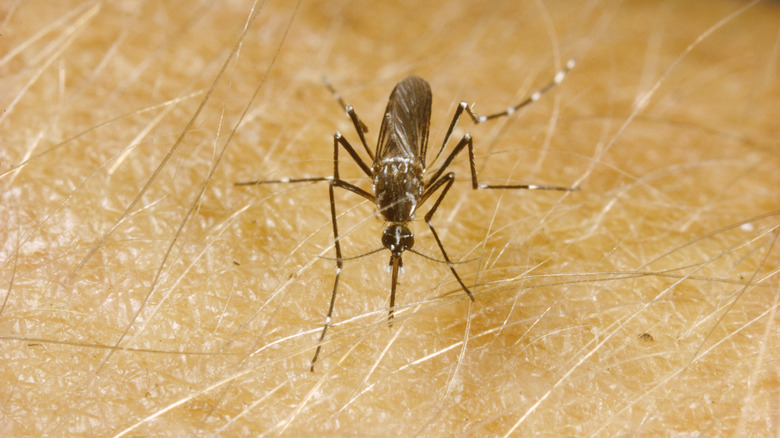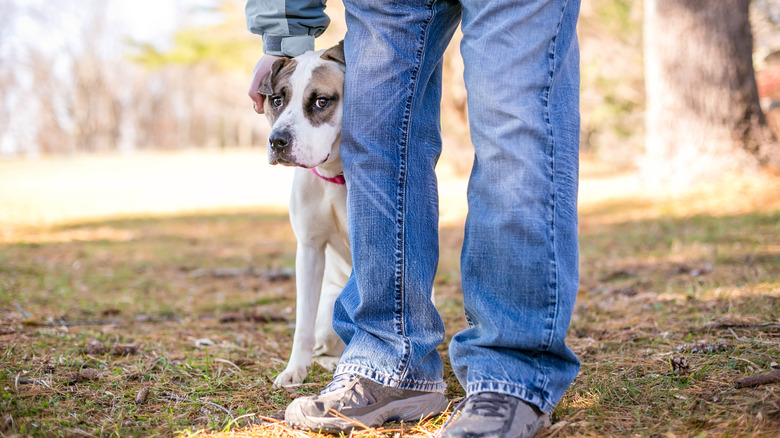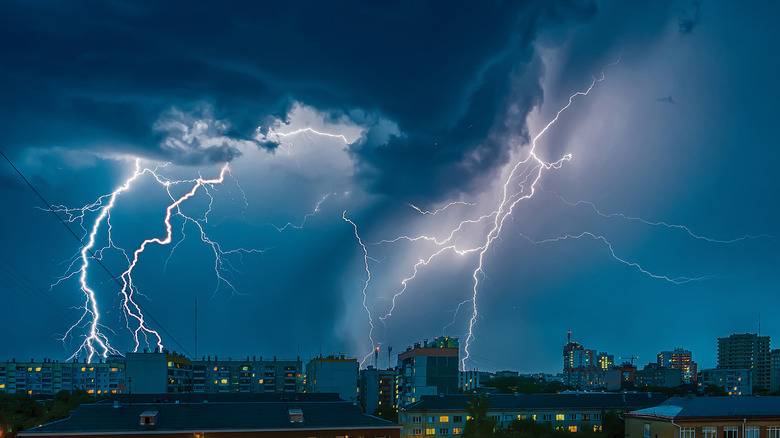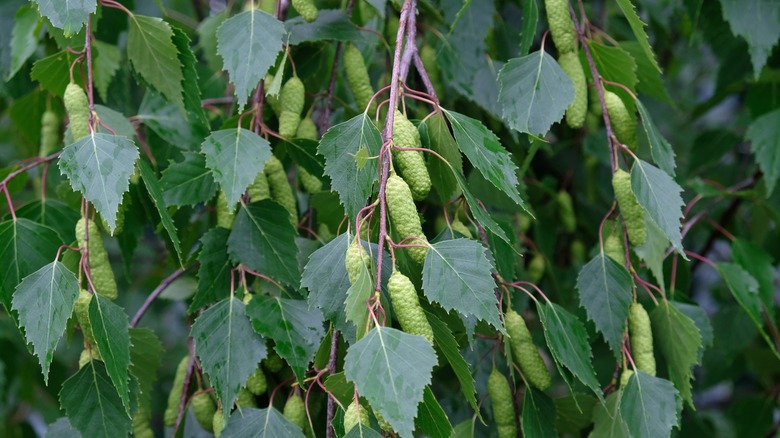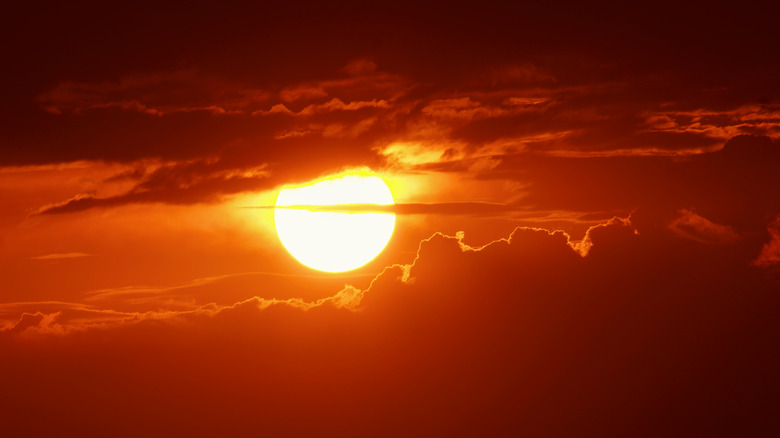13 Ways To Predict The Weather: Watch For These Signs In Nature
Remember when you were a child, and someone would lick their finger, then hold it out in the air to feel which way the wind was coming? The idea seems pretty straightforward: Whichever side of your finger cools and dries the fastest tells you where the wind's coming from. Of course, this method isn't very effective. There are easier ways — such as observing windblown flora — to find a natural weathervane.
Humans have tried for millennia to understand — and predict — the weather. Many societies believed bad weather to be a reflection of the gods' ire and thought they could secure good weather with rituals and rain dances. Some tried a more scientific approach, such as Aristotle. His "Meteorologica" treatise evolved into meteorology, the study of weather we know today. Modern meteorology proves weather is far from simple. Scientists study for years to comprehend the workings of our planet's atmosphere and use supercomputers to predict the weather.
That said, are there any natural ways to predict the weather without instruments, or are they all mythological hokum? Our ancestors found some effective ways to glean a general forecast from Mother Nature, and there's historical evidence that people used some of them before meteorological stations were a thing. Whether you're worried about getting rained on at Disney World or the Grand Canyon, these amateur weather forecasting tips will come in handy.
Observe surrounding wildlife
Evolution has taught the animal kingdom very well how to prepare for a life-threatening weather event. If you and your babies get washed away by a sudden flood, your species won't last very long, will it? As a result, the behavior of many different types of animals could indicate big incoming weather changes.
Bees, for example, are highly sensitive to barometric pressure fluctuation — air pressure changes — and will work feverishly to collect pollen ahead of a storm before fleeing to the cover of their hive, according to a study by the Jiangxi Agricultural University. Ants likewise pick up the pace of work, and frogs croak more intensely. Crickets chirp at a higher frequency as the temperature increases, and you can get a rough estimate of the temperature by doing some math with those chirps.
There are other types of animal behaviors that may be linked to weather — such as sheep huddling together or wolves howling at odd hours — though science has yet to conclusively prove them. So what's the tip here? Pay attention to the baseline behavior of critters in your surrounding environment and take note if there's a sudden shift. It may be a sign things are going to get rough.
Do some birdwatching
Okay, so the average person will probably be avoiding bees and won't be studying anthills. Are there any animals that are easier to observe, with behaviors that are a little more obvious? Birds are a good one; as they are flying creatures, bad weather is a major threat to their existence. A study published in The Journal of Experimental Biology suggested that birds, like bees, sense changing barometric pressure as an indication of an incoming storm. This low pressure before a storm makes it harder for birds to fly, especially higher up in the atmosphere, so they're more likely to perch or roost and wait it out. If they do fly, it will be lower to the ground where air density is higher — and thus easier to negotiate.
There's even possible evidence that birds can hear a storm. Big storms — particularly tornadoes and hurricanes — produce a low-frequency "infrasound," which is below the human hearing threshold. Birds can hear infrasound; they likely use it to navigate. Scientists have observed birds fleeing an area to get ahead of an approaching storm.
Long story short, pay attention to the birds, whether you're at the best birdwatching destination to visit in America or just taking a Saturday hike. Are they feeding and playing high in the air (acting normal), or are they booking it out of there frantically and flying "under the radar?" The latter may suggest inclement weather is on the horizon.
Pay attention to mosquitoes
It may be difficult to determine if nearby birds are flitting away from a storm or a noisy human (you) disrupting their habitat. There may not even be enough birds in the immediate vicinity to make a precise determination in the first place. Something that will seldom be absent, though, are mosquitoes, and their behavior is much more straightforward. Many individuals have observed anecdotally that mosquitoes go into something of a feeding frenzy before a storm. This isn't a coincidence. This is because — you guessed it — evolution has perfected these little pests to predict and outlast storms.
It is thought that this gluttonous response arises when they sense low barometric pressure — the same cue for other species to react in atypical ways. It could also have to do with the fact that insects are cold-blooded; cloud cover and humidity before a storm create those soupy-hot conditions that bloodsuckers love most for feeding and reproducing.
Plus, we humans sweat like pigs in humidity, which only aids mosquitoes in homing in on us. So, if those mosquitoes are eating you alive, it could be something more than just your delicious blood and lack of DEET. They may be stocking up to wait out weather that will force them to go to ground — weather you may be keen on avoiding, too.
Listen to your body
Humans are animals, so it stands to reason that we ought to be able to detect weather like other species to some degree. After all, our human-like ancestors have been roaming the earth for at least 1.5 million years. You don't survive cataclysmic weather without some trick up your sleeve. That trick is your body. Listen closely, and in some cases, it may warn you about changing weather.
Studies have suggested that people prone to migraines may get a riotous headache as barometric pressure drops, the biggest environmental predictor of a forming storm. The same happens with those with arthritis or who have undergone joint replacements. Scientific evidence on the matter is fuzzy, but there are a ton of anecdotal accounts suggesting that people with these conditions really do "feel" changing weather. Then there are changes in appearance; humidity before rain gives some people a really bad hair day.
Those who went through a traumatic injury may also be prone to these weather changes. 13 News Now reports how the life of Eileen Fennel of Norfolk, Virginia, changed forever after a catastrophic accident. Aside from her lifelong injuries, she can predict rainstorms and snowstorms by the immense pain they put her in. In short, pay attention to your body. Some of our readers may react to it in unexpected ways.
Observe your pet's behavior
Are you a fur parent traveling with your pet? Your dog or cat may be an unwitting — yet effective — weather-predicting device. It's common knowledge that dogs get skittish when they hear thunder, but they may be able to hear those thunderheads coming long before you do. Even though the hearing range of dogs and cats is too high to hear infrasound like birds, they can feel barometric pressure with greater sensitivity, as well as changes in static electricity. Their excellent olfactory receptors allow them to detect the scent of ozone with greater acuity, too.
This can result in "storm anxiety." Pets may start bouncing off the walls in agitation the closer the storm gets. Your beloved Fido may shake, whimper, or exhibit destructive behavior. The most obvious sign is that a pet will flee to cover. If your furry friend is particularly communicative, it may seem like they're trying to say, "Hey, hooman, let's get out of here now!"
Scientific evidence for this is varied. Some studies provide limited evidence that intense weather events change your pet's behavior, but most of it is anecdotal. Still, pet owners insist this to be the case, and you may have observed it yourself. If your dog's acting funny, the answer may be a mean storm in the making.
Gauge the distance from lightning by counting
One trick you may have heard as a kid is that you can determine how far away a lightning storm is with simple math. You start counting immediately when you see a flash of lightning and stop when you hear the thunder that follows. You take that number and divide it by five to get the distance in miles. To the surprise of some, this isn't just some old-timey wisdom with no scientific foundation. It really works. Ask the National Weather Service.
The speed of sound means that thunder's sound waves will clear a mile in just five seconds. Using that metric, you can calculate the approximate distance with the above method. So, if it only takes five seconds or less to hear the thunder, you're uncomfortably close to the lightning. It's time to get to cover.
Granted, this technique is only useful at a relatively close distance. Humans can't hear the thunder that lighting produces when it's more than 10 miles away. Once you hear thunder — even if it's a long way away — you should remain alert since you're within "striking distance," according to the NWS. Lightning has a massive area of effect, as much as 10 miles beyond its parent rainstorm. Thunderbolts reach a temperature five times hotter than the sun, and lightning travels in multiple unpredictable channels. You don't want to be anywhere near the barrel of Zeus' weapon of choice when he pulls the trigger.
Smell for ozone
Here's a fancy word for you: petrichor. It's the combination of the Greek roots "petro" and "ichor," or, to put it very roughly, the "heavenly liquid of the earth." Chemists Isabel Joy Bear and Richard Grenfell Thomas coined the term in the '60s to describe the pleasant smell that occurs after rainfall. Petrichor is thought to be a combination of microorganisms in the soil, plant oils, and ozone, the latter being an atmospheric chemical. Ozone is the main component of petrichor and one you want to be on the lookout for.
Before it rains, ozone (or O3) descends from the upper atmosphere on the downdrafts created by storm activity. If you can smell ozone and there's no rain, it's a pretty strong sign that there will be some soon. If you're not sure what exactly ozone smells like, it's that "fresh," punchy smell that almost has a bit of "zing" to it. Sometimes, however, ozone can invoke a foul scent, particularly when it displaces whatever's lying on the concrete and asphalt in a city area.
Animals can detect petrichor (and thus ozone), too. Camels use it to find oases in the desert, and fish use it as a signal to kick off their spawning season. To be fair, you won't smell ozone unless a storm is already on your heels. But it's a good warning to seek overhead cover or risk getting drenched.
Notice an improved sense of smell
Anyone who's been to (or lives in) a humid place knows it's not just the blanket-like, suffocating heat you have to worry about. It's also the stink. Extra-humid places often carry a characteristic rotten aroma, as if you're standing in the midst of a garbage dump. It's not the humidity causing it; rather, how humidity influences our senses.
First of all, humid air "traps" existing smells and keeps them around for a long time when they'd otherwise dissipate in a dry climate so that stinky garbage on your curb or that compost pile in your yard reeks a lot worse than it usually might. But humidity goes a step further than that. Water molecules bind to odorous particles, effectively improving our sense of smell when it's humid. Those smells were always there, it's just that the humidity makes you more aware of them than when it's dry.
What does this have to do with the weather? Well, humidity increases in the run-up to a storm, especially since low barometric pressure is the result of an increase in humidity. The atmosphere is building up water vapor to make rain or ice crystals. Consequently, your sense of smell will improve. You might not immediately notice an increase in humidity, but you may notice your sense of smell improving due to the high water content in the air. In that case, it may be time to prep your raincoat.
Check plants for dew
Ever heard the phrase, "When the dew is on the grass, rain will never come to pass; When grass is dry at morning light, look for rain before the night?" It's the saying behind the idea that if the grass is dewy, you can expect good weather. The saying goes way back, clearly an old bit of farmer's aphoristic meteorology. Believe it or not, though, there is some truth behind it.
Some assume that when there's dew, there's not enough water in the air for a rainstorm. Not so. The answer has to do with nightly cloud cover. If the skies are clear during the nighttime, then any heat on the ground radiates away into space — cooling the earth and making the formation of condensation (or, in this case, dew) possible. Conversely, cloud cover acts as a blanket that traps heat and thus prevents the cooling necessary to facilitate dew formation.
If cloudiness is preventing condensation, then there's probably enough for a rainstorm during the coming day. In other words, if there's no dew, expect rain. Check nearby plants in the morning before the sun is fully up. The presence of dew — or lack thereof — may indicate what weather you should look forward to.
Check the tree leaves
Another bit of farmer's wisdom is the saying, "When leaves show their undersides, be very sure rain betides." Translation: flipped-over leaves mean rain is coming. This one might seem a bit obvious. If there's a lot of wind — such as before an imminent storm — then the leaves are going to flip over, right? True, but there's a bit more going on here.
We've established already that humidity comes into play when pressure is low prior to a storm. The heavy water vapor acts upon a tree's delicate leaf stems, moistening them so they're less stiff. The result? A leaf is going to flip over a lot more easily. You may notice this in the way trees (in general) seem a bit limp before a storm, even if the wind isn't blowing. That said, the flipped leaves symptom is most common among deciduous trees, particularly maples, oaks, and poplars. So, keep an eye out for trees that appear to be slumping or flipping their leaves under a weak gust. It could be indicative of an inbound storm.
Look at the pinecones
Don't be so quick to step on or kick those pinecones you find on the ground while outside. They may provide a very subtle bit of weather forecasting. Mature pinecones are a pine tree's means of reproduction, and it may come as a surprise that there are male and female ones. The former are of the soft, non-wooden variety that drop from the tree's lower branches to pollinate the females, which are the scaled, hard pinecones we all know so well. Those females contain the seeds, and with their help, you can glean a bit of the weather.
Humidity is the crucial factor here, again. Pinecones close before the rains to protect the seeds from unfavorable conditions, then reopen when it's dry again. Flooded earth may drown seeds and cause them to rot instead of gestate. The pinecone's opening and closing action occurs when the humidity levels swell up those woody plant cells, which then shrink back down to standard size in drier, sunnier conditions. So grab a nearby pinecone and take a look. If its spiny scales are sealed up tight, you may need to prepare for bad weather.
Take note of red skies
Here's yet another weather-related saying for you: "Red sky at night, sailor's delight, red sky in morning, sailor's warning." In essence, a red sunrise means rainy weather is coming; a red sunset means clear skies ahead. This sailor's wisdom goes way, way back. Jesus espoused it, and even Shakespeare had his own version. But it's also got a fair bit of truth to it, like the others we've mentioned.
Weather tends to move from west to east; thus, storms do, too. Sunlight passing through the atmosphere changes color depending on whether it's traveling through clear skies or heavy water vapor. Sunrise and sunset send light through the atmosphere's thickest angle, the perfect time to illuminate incoming or outgoing weather systems. Remember, the sun rises in the east and sets in the west, so in the morning, you see arriving weather, and in the evening, you see it leave.
With that in mind, a red sunset results from the high pressure, stable air, and dust particles of a tranquil weather system. Good weather is coming. On the other hand, a red sunrise presages the complete opposite. Since you're looking east, those favorable conditions have already passed, and there is the potential for bad weather to follow. It's not a guarantee, but pray for red sunsets and be wary of red sunrises.
Examine the clouds
Studying the clouds is a very effective means of predicting the weather, but only by a few minutes or hours at best — leaving you less time to find shelter than other methods on this list. Still, it pays to learn how clouds tick. As you possibly learned in elementary school, they come in many forms and atmospheric altitudes. Dark, murky storm clouds are an immediate giveaway that the sky's about to rain cats and dogs, but other clouds are more subtle in how they snitch about upcoming weather developments.
Cirrus clouds — the hair-clump-like, tiny, wispy ones — couldn't rain on you if they tried, but they often precede a warm front, that is, a tumultuous change of weather. Cirrocumulus — patchy, uniform blankets of clouds — usually indicate fair weather or a possible hurricane if you're in the tropics. Cirrostratus, altostratus, stratus, and nimbostratus all warn of some degree of drizzly, rainy, or gloomy weather.
Ironically, cumulus clouds — those massive, fluffy towers in the sky — are a good sign. Expect plenty of fair weather. That said, they can sometimes form into cumulonimbus thunderclouds, which means you're in for a gauntlet of the heavy stuff. Consider bringing a visual guidebook along for your travels with cloud shapes and their impact on weather. The names can quickly get confusing, so having a basis for comparison will make analysis much easier.
